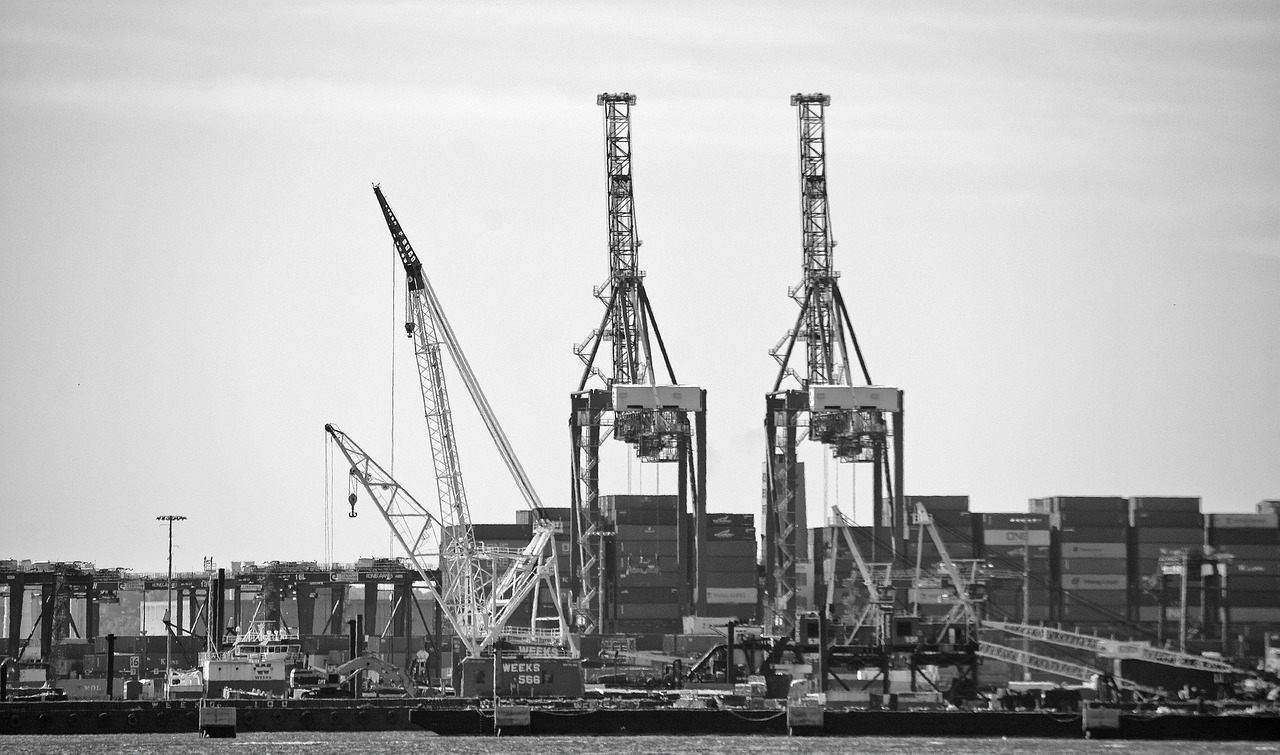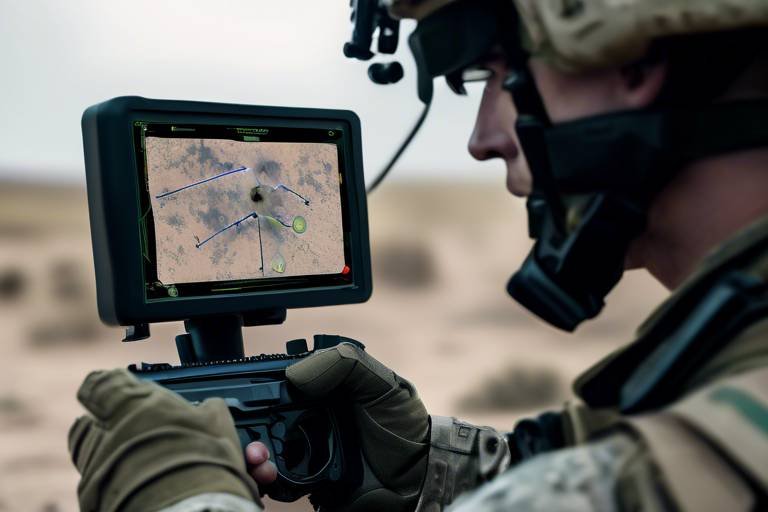The Impact of AI on Military Supply Chain Management
Artificial Intelligence (AI) is not just a buzzword anymore; it’s a game changer, especially in the realm of military supply chain management. Imagine a world where every logistical decision is backed by data, where resources are allocated with pinpoint accuracy, and where operational efficiency is not just a goal but a reality. This is the transformative power of AI in defense logistics. From predicting supply needs to optimizing inventory levels, AI technologies are revolutionizing how military organizations manage their supply chains, leading to enhanced efficiency, reduced costs, and improved decision-making processes.
In the fast-paced environment of military operations, the ability to adapt and respond to changing conditions is crucial. AI systems can analyze vast amounts of data at lightning speed, providing military planners with insights that were previously unimaginable. This capability not only enhances the effectiveness of supply chains but also ensures that troops have what they need when they need it. The stakes are high, and the pressure is immense, but with AI at the helm, military supply chains are becoming more resilient and responsive.
Moreover, the integration of AI into military logistics is not just about technology; it’s about people and processes. Skilled personnel are needed to interpret AI-driven insights, and organizations must adapt their workflows to leverage these new capabilities fully. As we delve deeper into this topic, we’ll explore how AI is reshaping military supply chains, the challenges that come with it, and what the future holds for this critical aspect of defense operations.
- What is the primary benefit of AI in military supply chain management?
AI enhances efficiency by optimizing logistics, predicting demand, and improving resource allocation. - How does predictive analytics work in military logistics?
It analyzes historical data and real-time information to forecast supply needs accurately. - What challenges do military organizations face when implementing AI?
Challenges include data integration, security concerns, and the need for skilled personnel. - What role does real-time data analysis play in decision-making?
It allows for quick responses to changing conditions, ensuring agile logistics operations. - What future trends can we expect in AI and military logistics?
Increased integration of autonomous systems and machine learning to further enhance supply chain operations.

Understanding Military Supply Chains
Military supply chains are the backbone of defense operations, ensuring that troops are equipped with the necessary resources, equipment, and personnel when they need them. Imagine a well-oiled machine, where every cog and wheel works in perfect harmony to deliver critical supplies to the front lines. This intricate network involves various components, including transportation, warehousing, and distribution, all of which must operate seamlessly to maintain operational readiness. The complexity of military supply chains arises from their need to adapt to rapidly changing environments and unpredictable challenges, making it imperative to have a thorough understanding of their structure.
At its core, a military supply chain consists of several key elements: procurement, storage, inventory management, and distribution. Each of these components plays a vital role in ensuring that resources are available when and where they are needed. For instance, procurement involves sourcing materials and equipment, while storage refers to the facilities that hold these supplies until they are required. Inventory management ensures that stock levels are optimized, preventing both shortages and excess. Finally, distribution is the process of delivering these resources to the end-user, often under challenging conditions.
To illustrate, consider a military operation in a remote area. The supply chain must be agile enough to respond to the needs of the troops on the ground. This means that logistics planners must have a clear understanding of not just the current inventory but also the anticipated demands based on mission objectives. Factors such as terrain, weather, and enemy activity can all influence supply needs, making it crucial for military leaders to have a comprehensive view of their supply chain operations.
Moreover, the integration of technology, particularly artificial intelligence, is revolutionizing how military supply chains are managed. AI can analyze vast amounts of data to identify patterns and trends, allowing for more informed decision-making. This technological advancement enhances the ability to forecast demand, streamline operations, and ultimately ensure that military personnel are equipped to perform their duties effectively. As we delve deeper into the role of AI in logistics optimization, it becomes evident that understanding the fundamental structure of military supply chains is essential for implementing these advanced solutions.
The challenges faced by military supply chains are not to be underestimated. From geopolitical factors to logistical hurdles, the landscape is fraught with obstacles that require innovative solutions. As military organizations continue to evolve, the need for a robust and adaptable supply chain becomes increasingly critical. In the following sections, we will explore how AI technologies are transforming these supply chains, paving the way for enhanced efficiency, reduced costs, and improved decision-making processes.
- What are the main components of a military supply chain?
The main components include procurement, storage, inventory management, and distribution.
- How does AI improve military supply chain management?
AI enhances supply chain management by analyzing data, predicting demand, and optimizing inventory levels.
- What challenges do military supply chains face?
Challenges include data integration, security concerns, and the need for skilled personnel to manage advanced technologies.

Role of AI in Logistics Optimization
Artificial Intelligence (AI) is not just a buzzword; it's a game-changer in the realm of logistics optimization, particularly within military supply chains. Imagine a system so intelligent that it can analyze mountains of data in seconds, predicting needs before they even arise. This is the power of AI in action, transforming traditional logistics into a dynamic, responsive network. The military's operational efficiency hinges on the ability to manage resources effectively, and AI is proving to be the backbone of this evolution.
One of the most significant contributions of AI is its ability to analyze vast data sets. By leveraging machine learning algorithms, military logistics can sift through historical data, current inventory levels, and even real-time operational updates. This analysis helps in predicting demand more accurately, ensuring that supplies are available just when they're needed. Think of it as having a crystal ball that not only forecasts demand but also adjusts supply routes and inventory levels in real time.
Furthermore, AI enhances inventory management. Traditional methods often lead to overstocking or stockouts, both of which can be costly and detrimental to military operations. With AI-driven systems, military organizations can maintain optimal stock levels, automate reordering processes, and minimize excess inventory. This not only contributes to cost savings but also ensures that resources are utilized efficiently. For instance, if a particular piece of equipment is frequently used in a specific region, the AI can recommend increasing stock levels in that area, thereby reducing response times during critical operations.
To illustrate the impact of AI on logistics optimization, consider the following table that compares traditional logistics management with AI-enhanced logistics:
| Aspect | Traditional Logistics | AI-Enhanced Logistics |
|---|---|---|
| Data Analysis | Manual, time-consuming | Automated, real-time |
| Demand Forecasting | Historical data only | Predictive analytics with real-time data |
| Inventory Management | Reactive | Proactive, automated |
| Cost Efficiency | Higher due to waste | Lower due to optimized resource allocation |
In addition to these advantages, AI also plays a crucial role in enhancing decision-making processes. By providing real-time insights, military leaders can make informed choices quickly, adapting to dynamic operational environments. This agility is vital in military logistics, where conditions can change in the blink of an eye. AI tools allow for swift adjustments, ensuring that logistics operations are not just responsive but also strategically aligned with overall mission objectives.
However, it’s important to acknowledge that the integration of AI into military logistics is not without its challenges. Data integration from various sources can be complex, and there are significant security concerns to address. Moreover, the need for skilled personnel to manage these advanced systems cannot be overstated. Yet, the potential benefits of AI in logistics optimization far outweigh these hurdles, paving the way for a more efficient and effective military supply chain.
- How does AI improve demand forecasting in military logistics? AI uses predictive analytics to analyze historical and real-time data, allowing military planners to anticipate supply needs accurately.
- What are the benefits of AI-driven inventory management? AI systems maintain optimal stock levels, automate reordering, and minimize excess inventory, leading to significant cost savings.
- What challenges exist in implementing AI in military supply chains? Key challenges include data integration, security concerns, and the need for skilled personnel to operate advanced AI systems.
- Will AI replace human decision-making in military logistics? While AI enhances decision-making by providing real-time insights, human oversight remains crucial for strategic planning and ethical considerations.

Predictive Analytics for Demand Forecasting
Predictive analytics has emerged as a game-changer in the realm of military logistics, especially when it comes to demand forecasting. Imagine being able to foresee the future needs of your military operations with precision. This is exactly what predictive analytics offers—an opportunity to anticipate supply requirements before they become critical. By leveraging advanced algorithms and machine learning techniques, military planners can analyze historical data and current trends to predict what supplies will be needed, and when. This proactive approach not only reduces waste but also ensures that resources are available right when and where they are needed the most.
At the heart of predictive analytics is the ability to sift through vast amounts of data. For instance, military organizations can utilize data from various sources such as historical usage patterns, real-time operational data, and even external factors like weather conditions and geopolitical developments. By integrating these diverse data points, predictive models can deliver insights that are both timely and relevant. This ensures that supply chains remain agile, capable of adapting to the unpredictable nature of military operations.
However, the journey to effective demand forecasting is not without its challenges. Implementing predictive analytics involves overcoming hurdles such as data integration, where disparate data systems must communicate effectively. Additionally, security concerns are paramount, as the sensitive nature of military data necessitates robust protection against cyber threats. Finally, there is a significant need for skilled personnel who are adept at interpreting data and translating it into actionable strategies. Despite these challenges, the potential benefits of predictive analytics in military supply chains are undeniable.
To illustrate the impact of predictive analytics, consider the following table that outlines the key benefits and challenges associated with its implementation in military logistics:
| Benefits | Challenges |
|---|---|
| Improved accuracy in demand forecasting | Data integration issues |
| Reduction in waste and excess inventory | Security concerns |
| Enhanced resource allocation | Need for skilled personnel |
| Increased agility in supply chain operations | Resistance to change within organizations |
In conclusion, predictive analytics is not just a technological advancement; it is a strategic necessity for modern military supply chains. By harnessing the power of data, military organizations can transform their logistics operations from reactive to proactive, ensuring that they are always prepared for whatever challenges lie ahead. As we continue to explore the capabilities of artificial intelligence in military logistics, the role of predictive analytics will undoubtedly grow, paving the way for more efficient and effective defense operations.
- What is predictive analytics? Predictive analytics involves using statistical algorithms and machine learning techniques to identify the likelihood of future outcomes based on historical data.
- How does predictive analytics benefit military logistics? It enhances demand forecasting, reduces waste, improves resource allocation, and increases the agility of supply chain operations.
- What are the challenges in implementing predictive analytics? Key challenges include data integration, security concerns, and the need for skilled personnel to interpret data effectively.
- Can predictive analytics adapt to changing conditions? Yes, predictive models can be updated with new data to adapt to changing operational environments and requirements.

Data Sources for Predictive Models
In the realm of military supply chain management, the accuracy of predictive models hinges on the quality and variety of data sources utilized. These data streams are the lifeblood of effective forecasting, enabling military planners to make informed decisions that can significantly enhance operational readiness. The integration of diverse data sources allows for a comprehensive view of the supply chain, akin to assembling a jigsaw puzzle where each piece adds clarity to the overall picture.
One of the primary data sources comes from historical usage patterns. By analyzing past consumption rates of equipment and supplies, military organizations can identify trends and seasonal fluctuations that impact future demand. For instance, if a particular unit consistently requires more ammunition during training exercises in the spring, this historical data can inform future stock levels. Additionally, real-time operational data plays a crucial role in shaping predictive models. This data can include everything from current inventory levels to the status of ongoing missions, providing a dynamic view of supply needs.
Moreover, external factors such as geopolitical events, environmental conditions, and logistical constraints can also serve as valuable data sources. For example, a sudden change in the political landscape may necessitate an increase in supplies for a specific region, while adverse weather conditions could disrupt transportation routes, affecting delivery schedules. By incorporating these variables into predictive analytics, military planners can better prepare for unexpected scenarios.
It's essential to recognize that the effectiveness of these predictive models is not solely dependent on the quantity of data but also on its quality. Data must be accurate, timely, and relevant to ensure that forecasts are reliable. This often requires the implementation of robust data governance practices, including regular audits and updates to the data collection processes. As military logistics become increasingly complex, the ability to synthesize information from multiple sources into actionable insights will be critical.
To summarize, the data sources for predictive models in military supply chains are multifaceted and include:
- Historical Usage Patterns: Past consumption data that helps identify trends.
- Real-Time Operational Data: Current inventory and mission status.
- Geopolitical Factors: External events that may influence supply needs.
- Environmental Conditions: Weather and other factors affecting logistics.
Incorporating a diverse array of data sources not only enhances the predictive capabilities of military supply chains but also fortifies their resilience against unforeseen challenges. As technology advances and data becomes more accessible, the potential for AI-driven predictive analytics in military logistics will continue to expand, paving the way for a more agile and responsive supply chain.
- What are predictive models in military logistics?
Predictive models use historical and real-time data to forecast future supply needs, helping military planners optimize resource allocation. - How does AI improve supply chain management?
AI enhances supply chain management by analyzing vast amounts of data, improving demand forecasting, and optimizing inventory levels. - What challenges are faced in implementing AI in military logistics?
Challenges include data integration, security concerns, and the need for skilled personnel to manage advanced systems.

Challenges in Implementing Predictive Analytics
This article explores how artificial intelligence is transforming military supply chain management, enhancing efficiency, reducing costs, and improving decision-making processes in defense logistics.
Military supply chains are complex networks that ensure the timely delivery of resources, equipment, and personnel. Understanding their structure is crucial for implementing effective AI solutions.
AI technologies play a pivotal role in optimizing logistics by analyzing vast data sets, predicting demand, and improving inventory management, thereby enhancing operational efficiency in military supply chains.
Predictive analytics enables military planners to anticipate supply needs accurately, reducing waste and ensuring resources are available when and where they are needed most.
Various data sources, including historical usage patterns and real-time operational data, feed into predictive models, allowing for more accurate forecasting and resource allocation in military logistics.
Implementing predictive analytics in military supply chains presents a unique set of challenges that can hinder its effectiveness. One of the primary hurdles is data integration. Military organizations often operate with disparate systems that generate data in various formats. Integrating these systems into a cohesive unit can be a daunting task, requiring significant time and resources. Additionally, the sheer volume of data can be overwhelming, making it difficult to extract actionable insights.
Another critical challenge is security concerns. The sensitive nature of military operations means that data breaches can have severe consequences. Organizations must ensure that their predictive analytics systems are secure, which often involves implementing complex cybersecurity measures that can slow down the deployment of these technologies.
Moreover, there is a persistent shortage of skilled personnel who are proficient in data science and analytics. Military supply chains require experts who not only understand the technical aspects of predictive analytics but also have a deep understanding of military logistics. This skill gap can delay the implementation of AI solutions, as organizations struggle to find qualified individuals to lead these initiatives.
Finally, organizational resistance can also pose a significant barrier. Change is often met with skepticism, especially in established military environments. Convincing stakeholders of the value of predictive analytics and securing their buy-in is crucial for successful implementation. Without a culture that embraces innovation and adapts to new technologies, even the most sophisticated predictive models can fall flat.
AI-driven inventory management systems help military organizations maintain optimal stock levels, automate reordering processes, and minimize excess inventory, contributing to cost savings and efficiency.
AI enhances decision-making processes by providing real-time insights and analytics, enabling military leaders to make informed choices quickly in dynamic operational environments.
Real-time data analysis allows military supply chain managers to respond swiftly to changing conditions, ensuring that logistics operations remain agile and effective.
AI tools assist in identifying potential risks within the supply chain, enabling military organizations to develop strategies for mitigation and maintain operational continuity.
The future of military logistics will likely see increased integration of AI technologies, including autonomous systems and machine learning, reshaping how supply chains operate and respond to challenges.
- What is predictive analytics in military logistics?
Predictive analytics involves using statistical algorithms and machine learning techniques to identify the likelihood of future outcomes based on historical data. In military logistics, it helps forecast supply needs and optimize resource allocation. - What are the main challenges of implementing AI in military supply chains?
Challenges include data integration, security concerns, a shortage of skilled personnel, and organizational resistance to change. - How can AI improve decision-making in military logistics?
AI can provide real-time insights and analytics, enabling military leaders to make informed decisions quickly, adapt to changing conditions, and enhance operational efficiency. - What future trends can we expect in military logistics?
We can expect increased integration of AI technologies, the use of autonomous systems, and advancements in machine learning that will further enhance the efficiency and responsiveness of military supply chains.

AI-Driven Inventory Management
In the fast-paced world of military operations, maintaining optimal inventory levels is akin to keeping a well-tuned engine running smoothly. systems are revolutionizing the way military organizations handle their supplies, ensuring that they have the right resources at the right time without the burden of excess stock. Imagine a scenario where military planners can predict their inventory needs with pinpoint accuracy—this is no longer just a dream but a reality thanks to advanced AI technologies.
These systems leverage machine learning algorithms to analyze historical data, current inventory levels, and upcoming operational requirements. By doing so, they can automate reordering processes, which not only saves time but also minimizes the risk of human error. For instance, if a particular piece of equipment is frequently used during training exercises, the AI can recognize this pattern and ensure that stock levels are adjusted accordingly. This proactive approach is crucial for maintaining operational readiness.
Additionally, AI-driven inventory management can significantly enhance cost efficiency. By minimizing excess inventory, military organizations can redirect funds to other critical areas, such as training or technology upgrades. Consider the following table that outlines the potential cost savings achieved through AI-driven inventory management:
| Inventory Management Method | Average Cost Savings (%) |
|---|---|
| Traditional Inventory Management | 10-15% |
| AI-Driven Inventory Management | 20-30% |
Furthermore, these systems can generate real-time insights into stock levels, allowing military leaders to make informed decisions quickly. For instance, if a sudden deployment is ordered, AI can instantly assess current inventory and recommend adjustments to meet urgent needs. This capability significantly enhances the agility of military operations, ensuring that logistics support is always one step ahead.
However, like any technological advancement, does come with its challenges. Implementing such systems requires a robust data infrastructure and skilled personnel who can interpret the data effectively. Moreover, security concerns regarding sensitive information must be addressed to ensure that operational integrity is maintained. Nevertheless, the benefits far outweigh the challenges, making AI-driven inventory management an essential component of modern military logistics.
- What is AI-driven inventory management? - It refers to the use of artificial intelligence technologies to optimize inventory levels, automate reordering processes, and improve overall supply chain efficiency.
- How does AI improve inventory accuracy? - AI analyzes historical data and current inventory trends to predict future needs, reducing the chance of stockouts or overstocking.
- What are the cost benefits of AI-driven inventory management? - Organizations can save 20-30% on inventory costs compared to traditional methods, allowing reallocation of funds to other critical areas.
- What challenges come with implementing AI in inventory management? - Key challenges include the need for a robust data infrastructure, skilled personnel, and addressing security concerns.

Enhancing Decision-Making with AI
In today's fast-paced military environment, the ability to make quick and informed decisions can mean the difference between success and failure. Artificial Intelligence (AI) is revolutionizing this landscape by providing tools that enhance decision-making processes. Imagine having a personal assistant that not only organizes your tasks but also predicts the best course of action based on real-time data. That's what AI brings to military logistics. It analyzes vast amounts of information and presents actionable insights that help military leaders respond to situations with unparalleled speed and accuracy.
One of the most significant advantages of AI in decision-making is its capability for real-time data analysis. Traditionally, military supply chain managers relied on static reports that could quickly become outdated. However, with AI, data is continuously gathered and analyzed, allowing for dynamic adjustments to logistics operations. For instance, if a supply route becomes compromised, AI can instantly assess alternative routes and recommend the most efficient option, ensuring that resources reach their destination without delay. This agility is crucial in military operations where every second counts.
Moreover, AI contributes to risk management and mitigation. By utilizing advanced algorithms, AI tools can identify potential risks within the supply chain before they escalate into significant issues. For example, if there is a sudden spike in demand for a specific resource, AI can alert decision-makers to the potential for shortages, enabling them to take proactive measures. This predictive capability not only enhances operational continuity but also fosters a culture of readiness and resilience within military organizations.
To illustrate the impact of AI on decision-making, consider the following table that summarizes key benefits:
| Benefit | Description |
|---|---|
| Real-Time Insights | Continuous data analysis allows for immediate adjustments to logistics operations. |
| Enhanced Agility | Quickly adapt to changing conditions and requirements in the field. |
| Proactive Risk Management | Identify potential supply chain risks and mitigate them before they impact operations. |
| Informed Decision-Making | Access to accurate data enables military leaders to make better choices. |
In conclusion, the integration of AI in military supply chain management is not just a trend; it is a transformative force that enhances decision-making capabilities. By leveraging real-time data and predictive analytics, military leaders can operate with greater efficiency, agility, and foresight. As we look to the future, the role of AI in military logistics will only expand, paving the way for smarter, more resilient operations.
- How does AI improve military logistics?
AI improves military logistics by providing real-time data analysis, enhancing risk management, and optimizing decision-making processes.
- What are the main challenges of implementing AI in military supply chains?
Challenges include data integration, security concerns, and the need for skilled personnel to manage AI systems.
- Can AI predict future supply needs?
Yes, AI uses predictive analytics to forecast demand based on historical data and real-time operational trends.

Real-Time Data Analysis
In the fast-paced world of military logistics, emerges as a game changer. Imagine being in a high-stakes chess match where every move counts; this is exactly how military supply chain managers must operate. They need to make decisions on the fly, and having access to real-time data is akin to having a crystal ball that reveals the best possible moves. By leveraging advanced AI technologies, military organizations can analyze data as it streams in, allowing them to react swiftly to any changes in the operational landscape.
One of the most significant advantages of real-time data analysis is its ability to provide immediate insights into various supply chain parameters. For instance, when a sudden demand surge occurs due to unexpected military engagements, real-time data enables commanders to adjust logistics strategies promptly. This capability not only ensures that troops have the necessary supplies but also minimizes the risk of overstocking, which can lead to waste and increased costs.
Furthermore, real-time data analysis facilitates enhanced communication across different branches of the military. With a centralized data system, information regarding supply levels, transportation routes, and equipment status can be shared instantly. This interconnectedness allows for collaborative decision-making and ensures that all stakeholders are on the same page. For example, if a particular route becomes compromised, real-time data can alert logistics teams to reroute supplies, maintaining the flow of resources without delay.
To illustrate the impact of real-time data analysis, consider the following table that outlines key benefits:
| Benefit | Description |
|---|---|
| Speed | Enables rapid responses to changing conditions in the field. |
| Accuracy | Improves decision-making through precise, up-to-date information. |
| Collaboration | Enhances communication among different military units. |
| Cost-Effectiveness | Reduces waste by optimizing resource allocation in real-time. |
However, it's essential to recognize that real-time data analysis is not without its challenges. The quality and reliability of data are paramount; if the data being analyzed is flawed or outdated, the decisions made based on that analysis can lead to disastrous outcomes. Additionally, the integration of various data sources must be seamless to provide a comprehensive view of the supply chain. Therefore, military organizations must invest in robust data management systems and ensure that personnel are trained to interpret and act on the insights generated effectively.
In conclusion, real-time data analysis is a critical component of modern military supply chain management. By harnessing the power of AI, military leaders can not only enhance their operational efficiency but also ensure that they are always one step ahead in the game. This capability ultimately translates to better support for troops on the ground, ensuring that they have the resources they need when they need them most.
- What is real-time data analysis in military logistics? - It refers to the immediate processing and analysis of data as it becomes available, allowing for quick decision-making.
- How does AI enhance real-time data analysis? - AI algorithms can process vast amounts of data quickly, providing actionable insights that human analysts may miss.
- What are the challenges of implementing real-time data analysis? - Challenges include ensuring data quality, integrating various data sources, and training personnel to use these systems effectively.

Risk Management and Mitigation
In the intricate world of military supply chains, risk management is not just a buzzword; it's a necessity. With numerous moving parts, from personnel to equipment, the potential for disruptions is ever-present. That's where artificial intelligence (AI) steps in, acting as a powerful ally in identifying and mitigating risks before they escalate into significant issues. Imagine having a crystal ball that not only predicts potential pitfalls but also suggests actionable strategies to navigate them. Sounds like something out of a sci-fi movie, right? Well, the future is here!
AI tools are designed to analyze vast amounts of data from various sources, including historical performance metrics, real-time operational data, and even external factors like weather conditions and geopolitical events. By synthesizing this information, military organizations can pinpoint vulnerabilities within their supply chains. For instance, if a particular route for transporting supplies is prone to delays due to adverse weather, AI can recommend alternative paths or adjust delivery schedules proactively. This kind of foresight is invaluable, ensuring that military operations can maintain momentum even in the face of unforeseen challenges.
One of the most significant advantages of AI in risk management is its ability to automate the identification of potential risks. With machine learning algorithms, AI can continuously learn from new data and adapt its risk assessment models accordingly. This means that as conditions change, so too does the AI's understanding of what constitutes a risk. For example, if a specific supplier has a history of delays, the AI can flag this supplier in real time, allowing decision-makers to seek alternatives before a shortage occurs.
Moreover, AI enhances the decision-making process by providing military leaders with actionable insights. Instead of sifting through mountains of data or relying on gut feelings, commanders can access real-time analytics that highlight risks and suggest mitigation strategies. This capability not only speeds up the decision-making process but also increases the accuracy of those decisions, ultimately leading to more efficient and effective military operations.
To further illustrate the impact of AI on risk management, consider the following table that outlines key risk factors in military supply chains and how AI addresses them:
| Risk Factor | AI Solution |
|---|---|
| Supply Chain Disruptions | AI predicts disruptions based on historical and real-time data, enabling proactive adjustments. |
| Inventory Shortages | AI monitors inventory levels and forecasts needs, automating reordering processes. |
| Supplier Reliability | AI evaluates supplier performance and flags those with a history of issues. |
| Geopolitical Risks | AI analyzes external data to assess risks related to political instability in supplier regions. |
Ultimately, AI doesn't just react to risks; it transforms the entire approach to risk management in military logistics. By leveraging advanced analytics and machine learning, military organizations can ensure operational continuity and maintain a strategic advantage. In a landscape where every second counts, having the ability to foresee and mitigate risks can be the difference between success and failure. So, as we look to the future, it's clear that AI will play a pivotal role in shaping resilient military supply chains.
- How does AI improve risk management in military supply chains?
AI analyzes vast data sets to identify potential risks, enabling proactive decision-making and timely responses to disruptions. - What types of data does AI use for risk assessment?
AI utilizes historical performance metrics, real-time operational data, and external factors like weather and geopolitical events. - Can AI predict future risks?
Yes, AI continuously learns from new data, allowing it to adapt its risk assessment models and predict potential future risks. - How does AI enhance decision-making in military logistics?
AI provides real-time insights and analytics, allowing military leaders to make informed decisions quickly in dynamic operational environments.

Future Trends in AI and Military Logistics
The landscape of military logistics is on the brink of a revolutionary transformation, driven by the rapid advancements in artificial intelligence (AI) technologies. As we look to the future, we can expect a myriad of trends that will not only enhance the efficiency of military supply chains but also redefine how military operations are conducted. Imagine a world where autonomous systems deliver supplies without human intervention, or where machine learning algorithms predict logistical needs with pinpoint accuracy. This is not just a fantasy; it’s a glimpse into the future of military logistics.
One of the most exciting trends is the increasing integration of autonomous vehicles in supply chain operations. These vehicles can navigate challenging terrains and deliver supplies directly to troops in the field, reducing the risk to human life and increasing the speed of logistics. Moreover, with the advent of drone technology, the military can deploy aerial delivery systems that can quickly transport critical supplies, such as medical equipment or ammunition, to remote locations. This capability not only enhances operational readiness but also ensures that resources are available when and where they are needed most.
Additionally, machine learning will play a pivotal role in analyzing data from various sources to optimize logistics strategies. By continuously learning from historical data and real-time inputs, AI systems can forecast demand more accurately, allowing military planners to allocate resources efficiently. This predictive capability will reduce waste and ensure that the military is always prepared for any situation, much like a chess player anticipating their opponent's moves.
Furthermore, we can expect a shift towards collaborative logistics, where military organizations collaborate with commercial supply chain partners. This partnership can lead to shared resources, improved technology access, and enhanced logistical capabilities. For instance, by leveraging commercial technology, the military can adopt advanced inventory management systems that utilize AI to maintain optimal stock levels, automate reordering processes, and minimize excess inventory.
As we embrace these advancements, it's essential to consider the challenges that accompany them. Issues such as data security and the need for skilled personnel to manage these sophisticated systems will be paramount. Military organizations must invest in training and development to ensure that their workforce is equipped to handle the complexities of AI technologies.
In conclusion, the future of AI in military logistics is not just about technology; it’s about creating a responsive, agile, and efficient supply chain that can adapt to the ever-changing demands of military operations. By harnessing the power of AI, military organizations can ensure that they are not only prepared for the challenges of today but are also equipped for the uncertainties of tomorrow.
- What role does AI play in military logistics? AI enhances efficiency, improves decision-making, and optimizes supply chain management through predictive analytics and real-time data analysis.
- How will autonomous vehicles impact military supply chains? Autonomous vehicles will reduce risks to personnel and speed up the delivery of supplies, making logistics operations more efficient.
- What challenges does the military face in implementing AI technologies? Key challenges include data integration, security concerns, and the need for skilled personnel to manage advanced AI systems.
- Will AI completely replace human roles in military logistics? While AI will automate many processes, human oversight and decision-making will remain crucial for effective logistics management.
Frequently Asked Questions
- What is the role of AI in military supply chain management?
AI plays a transformative role in military supply chain management by enhancing efficiency, reducing costs, and improving decision-making processes. It analyzes large data sets to optimize logistics, predict demand, and manage inventory effectively.
- How does predictive analytics benefit military logistics?
Predictive analytics helps military planners accurately forecast supply needs, which reduces waste and ensures that resources are available when and where they are needed. This proactive approach allows for better resource allocation and operational readiness.
- What challenges are faced when implementing AI in military supply chains?
Implementing AI in military supply chains comes with challenges such as data integration, security concerns, and the need for skilled personnel. Addressing these issues is crucial for leveraging AI's full potential in logistics.
- How does AI improve inventory management in military operations?
AI-driven inventory management systems help maintain optimal stock levels, automate reordering processes, and minimize excess inventory. This leads to significant cost savings and enhances the overall efficiency of military supply chains.
- What is the impact of real-time data analysis on military logistics?
Real-time data analysis allows military supply chain managers to respond swiftly to changing conditions. This agility ensures that logistics operations remain effective and can adapt to dynamic operational environments.
- How does AI assist in risk management within military supply chains?
AI tools help identify potential risks within the supply chain, enabling military organizations to develop strategies for mitigation. This proactive risk management is essential for maintaining operational continuity and effectiveness.
- What future trends can we expect in AI and military logistics?
The future of military logistics is likely to see increased integration of AI technologies, including autonomous systems and machine learning. These advancements will reshape how supply chains operate and respond to challenges, making them more efficient and resilient.


















